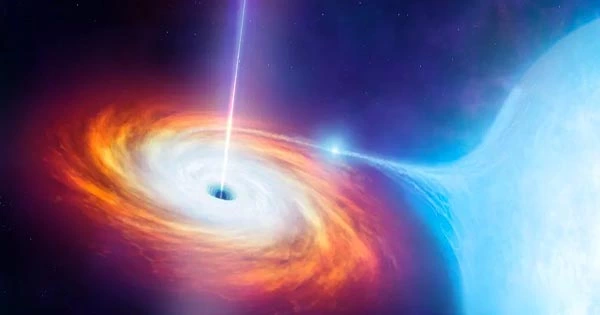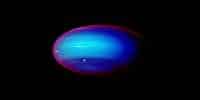One of the largest black hole jets in the sky has been uncovered by astronomers at Western Sydney University.
The jet leaves a black hole with massive energy and travels almost as fast as light, covering a distance of more than a million light years. But it doesn’t always get its way in the vast voids between galaxies.
Looking more closely: In cosmic terms, the galaxy NGC2663 is close by, being only 93 million light-years away. NGC2663 is located near one or two of the suburbs of our galaxy.
With nearly ten times as many stars as our own Milky Way, it has the recognizable oval shape of a “typical” elliptical galaxy when viewed through a standard telescope.
That is until we discovered NGC2663 using CSIRO’s Australian Square Kilometre Array Pathfinder (ASKAP), a system of 36 connected radio dishes acting as a single super-telescope in Western Australia.
A core black hole’s jet of stuff is visible in the radio waves as it leaves the galaxy. If our eyes could see it in the night sky, it would be larger than the Moon. This powerful torrent of material is approximately 50 times larger than the galaxy.
Although similar jets have been discovered before, NGC 2663’s enormous size (more than a million light-years across) and proximity to Earth make these among the largest known jets in the sky.
Surprise diamonds: What then did we see when an extragalactic jet was observed with the accuracy and power of ASKAP up close?
This study, which is being conducted by Western Sydney University doctorate student Velibor Velovi, has been accepted for publication in the journal Monthly Notices of the Royal Astronomical Society (preprint available here). We can find signs of the matter between galaxies pushing back on the sides of the jet in our Evolutionary Map of the Universe (EMU) survey.
Similar to an effect seen in jet engines, this procedure. The surrounding pressure pushes the exhaust plume from the sides as it rockets through the atmosphere. As a result, the jet pulsates while expanding and contracting.
The largest one so far: Shock diamonds have been observed in smaller, galaxy-sized jets as well as in jet engines. Jets have been observed slamming into dense gas clouds, illuminating them as they passed through. However, a more subtle effect that makes it more difficult to see is the restriction of jets from the sides.
We haven’t, however, observed this effect on such massive scales before NGC2663.
This demonstrates that NGC 2663 is surrounded by enough stuff to push against the sides of the jet. The jet then presses and warms the substance.
A feedback loop is created when intergalactic matter enters a galaxy, the galaxy creates a black hole, the black hole releases a jet, and the jet decreases the inflow of intergalactic matter into galaxies.
As the universe expands, these jets have an impact on how gas condenses into galaxies. It’s intriguing to observe this connection in such clear detail.
The EMU survey, which is also credited with discovering a new category of enigmatic astronomical object known as an “Odd Radio Circle,” is still scanning the sky. Numerous new discoveries will soon be added to this amazing radio jet.
As we proceed, we will gain a deeper comprehension of how black holes directly influence the galaxies that grow around them.
Luke Barnes, a lecturer in physics at Western Sydney University; Miroslav Filipovic, a professor there; Ray Norris, a professor in the school of science there; and Velibor Velovi, a candidate there.
A Creative Commons license has been used to republish this article from The Conversation. Check out the original article.
















